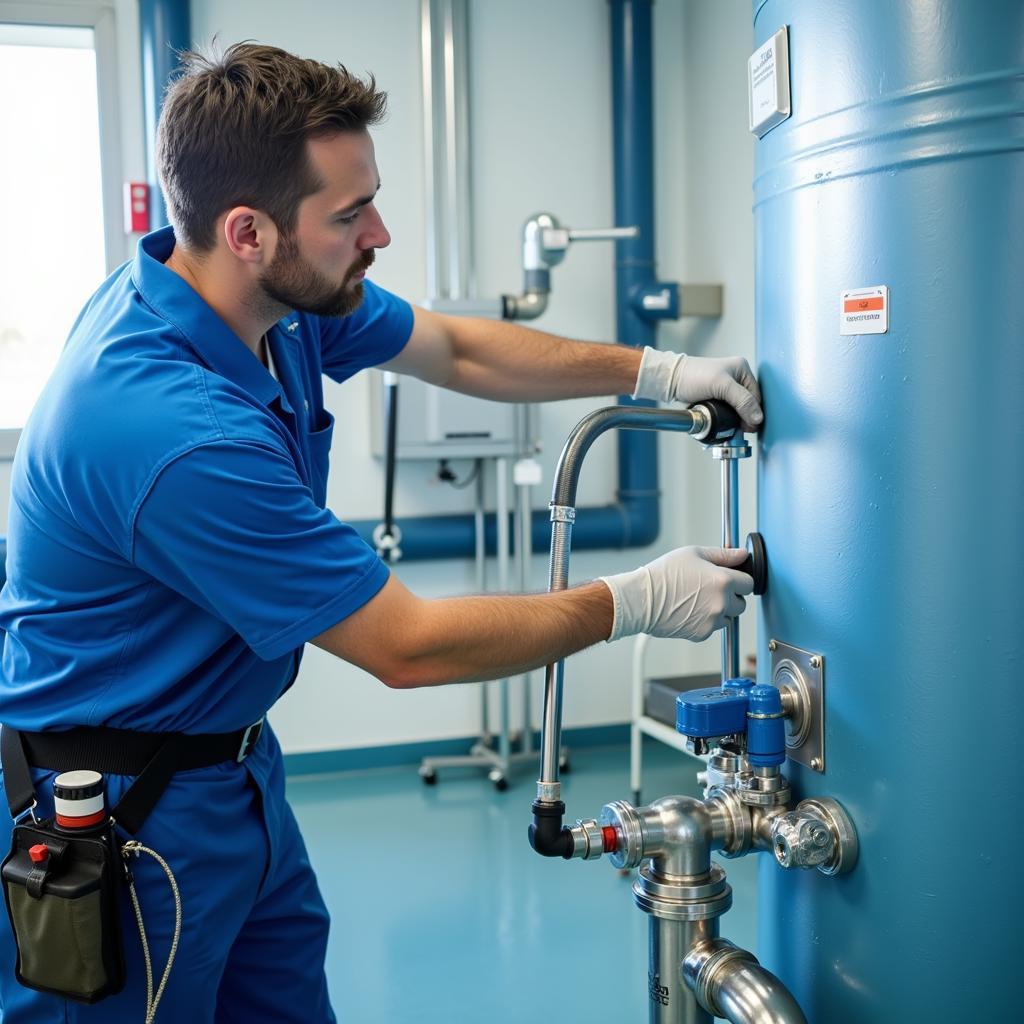Hospital Tank systems are a critical component of any healthcare facility’s infrastructure, playing a vital role in ensuring continuous water supply for essential medical procedures, sanitation, and fire suppression. These specialized tanks act as a reliable reservoir, safeguarding against water outages and providing a crucial buffer during peak demand periods.
Why Are Hospital Tank Systems Essential?
The uninterrupted operation of a hospital relies heavily on a constant and readily available water supply. Unlike other buildings where temporary disruptions might be tolerable, hospitals require a robust and resilient water system to address a range of critical needs:
- Patient Care: From basic hygiene and hydration to complex surgical procedures and dialysis, water is fundamental to almost every aspect of patient care.
- Sanitation and Sterilization: Maintaining a sterile environment is paramount in hospitals to prevent the spread of infections. Water is crucial for cleaning, disinfection, and sterilization of equipment and facilities.
- Fire Suppression: Hospitals house flammable materials and sensitive equipment, making fire safety a top priority. Sprinkler systems, often connected to dedicated hospital tanks, provide immediate fire suppression capabilities.
Types of Hospital Tanks
Hospital tank systems often utilize a combination of tank types, each designed for specific purposes:
- Potable Water Tanks: These tanks store treated water safe for human consumption, used for drinking, food preparation, and medical procedures.
- Fire Water Tanks: Designed to meet fire safety regulations, these tanks store large volumes of water exclusively for fire sprinkler systems and firefighting efforts.
- Isolation Tanks: These tanks hold water that may have been exposed to contamination, preventing cross-contamination with the main water supply until testing and treatment are complete.
Key Features of Hospital Tank Systems
Modern hospital tank systems are complex installations incorporating advanced features to ensure reliability, safety, and compliance with stringent healthcare regulations:
- Multiple Tank Configuration: Most hospitals employ multiple tanks to provide redundancy and ensure water availability even if one tank requires maintenance or repair.
- Corrosion-Resistant Materials: Tanks are constructed from durable materials like fiberglass, stainless steel, or concrete lined with protective coatings to prevent corrosion and ensure long-term water quality.
- Regular Inspection and Maintenance: Hospital tank systems undergo rigorous inspection and maintenance schedules to identify potential issues, prevent contamination, and ensure optimal performance.
- Emergency Backup Power: Pumps and control systems are connected to backup power sources to guarantee continuous operation during power outages, further enhancing system reliability.
 Hospital Tank System Maintenance
Hospital Tank System Maintenance
Hospital Wayfinding Signage and Tank Systems
While hospital tank systems operate behind the scenes, clear and effective wayfinding signage is essential for navigating the complex infrastructure of a hospital. Strategically placed hospital wayfinding signage ensures that staff and emergency responders can quickly locate and access these critical systems in case of emergencies or maintenance requirements.
For example, clear signage indicating the location of fire water tanks and isolation valves is crucial for firefighters responding to an incident. Similarly, corridor in hospital signage directing maintenance personnel to the location of water tanks and associated equipment can save valuable time and prevent potential disruptions.
“Effective wayfinding signage, especially in relation to critical infrastructure like hospital tank systems, is not just about convenience; it’s about safety and efficiency,” says Dr. Emily Carter, a leading expert in hospital design and safety. “Clear signage can mean the difference between a swift response and a potential delay in critical situations.”
Conclusion
Hospital tank systems are a vital component of any healthcare facility, playing a critical role in patient care, sanitation, and fire safety. By understanding the importance of these systems and their key features, hospitals can ensure their facilities have the reliable water infrastructure needed to provide high-quality patient care and maintain a safe and hygienic environment. Remember, investing in a robust hospital tank system and clear hospital street sign is an investment in the well-being of patients and the smooth operation of the entire healthcare facility.
FAQs
1. How often should hospital tanks be inspected?
Regular inspections are crucial, with recommendations varying based on local regulations and tank type. Generally, inspections are recommended at least annually, with more frequent checks for tanks storing potable water.
2. What is the lifespan of a hospital tank?
The lifespan depends on the tank material, maintenance practices, and operating conditions. Properly maintained tanks can last several decades.
3. What are the signs of a problem with a hospital tank system?
Signs include leaks, water discoloration or odor, low water pressure, and unusual noises from pumps or pipes.
4. What are the consequences of a hospital tank system failure?
Failure can disrupt medical procedures, compromise sanitation, and hinder fire suppression efforts, potentially jeopardizing patient safety and overall hospital operations.
5. How can hospitals improve the sustainability of their tank systems?
Implementing water-saving fixtures, utilizing rainwater harvesting systems, and opting for energy-efficient pumps can enhance the sustainability of hospital tank systems.
For any inquiries or assistance regarding hospital tank systems, please contact us at:
Phone Number: 02437655121
Email: [email protected]
Our team is available 24/7 to provide comprehensive support and address your needs.